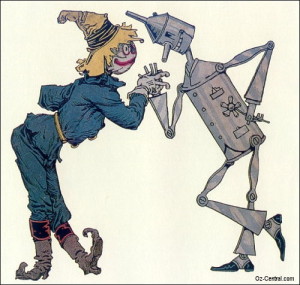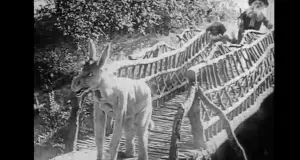
You might have heard about the movie coming out next month from Disney titled Oz: The Great and Powerful. It’s another film based on Frank L. Baum’s series about that little girl from Kansas with the dog and a propensity toward meeting creatures that are missing at least one vital body organ. With the movie coming out on March 8th of this year (2013), I can safely predict resurgence in popularity for the fourteen original old classics. Who can resist nostalgia? That’s great news for collectors.
The original Oz books written by Frank L. Baum between 1900 and 1920 have been in the public domain for quite some time, but even before they became fair game for bad writers to ruthlessly butcher, other authors had picked up and carried Baum’s torch, or pen, if you will. Ruth Plumly Thompson wrote about 20 or so Oz books from 1921 to 1939. While she lacked Baum’s wit and generally used her novels to quash any and all types of antidisestablishmentarians who happened find their way to Oz or the surrounding fairylands, all her novels were illustrated with the whimsical masterpieces by John R. Neil. Neil was not the original illustrator for the 1900 Dorothy and the Wizard of Oz, but his ink illustrations remained with the series for decades. Neil even added a few novels to the Oz canon himself.
By the time Judy Garland-gorgeous but clearly too developed for the role-burst into the land of the munchkins and onto the less-than-silver screen, she was already following in a movie making tradition dating back to 1910. Not all of Baum’s silent films were financial successes and none have stayed in the public memory as has the depression era masterpiece from MGM. However, through the magic of technology, the man in the poorly-stuffed donkey suit from The Patchwork Girl of Oz can be seen stumbling into a creek over and over in the comfort of people’s living rooms thanks to YouTube.

Another notable film development in the Oz series after the MGM film includes The Wiz (1978) wherein Dianna Ross, Richard Pryor and Micheal Jackson revive the roles in an all black cast. Probably the most underrated development in Oz films since the ruby slippers, Return to Oz (1985) introduced a wider audience to the major villain of the Oz series, the Nome King, and opened the door for another generation to rediscover what made the Oz books great in the first place.
And it’s not Oz itself that makes the Oz books great. Oz, as a fairyland, could not be duller. People have magic, but their beloved ruler, Ozma, outlaws it. In the four different color-cordinated countries, the inhabitants always have enough food and they cannot die. This would have been one of many forgotten series with which depression era families kept their homes warm by compassionately burning consequently saving later generations the agony of dealing with where to store bad old books, if it weren’t for the characters. The Oz series maintains its timeless appeal, because unlike most modern series full of vampires and werewolves and then some more vampires and an extra spattering of werewolves, the Oz creatures are generated by pure imagination.
When it comes to imagination in modern or what they call non-canonical Oz books, there are good, bad and brilliantly awful ones. Those seriously interested the best of Oz should explore the quirky illustrations by Scottie Young. The characters may be familiar, but style is whimsical and as modern as it is highly popular. While there’s no comprehensive anthology of Oz books, some authors have added great literature to the series, too. Consider anything from the Hunger Tiger Press to be safe. However, easier than identifying what is good is to point out and laugh at what is absolutely fireplace fodder like Jellia Jamb, Royal Maid of Oz. In this modern Oz novel, the maid from the Palace in the Emerald City goes into space and get creepily adult while the author struggles to maintain Baum’s middle grade appropriate writing style.
But despite all the new developments over the generations by talented writers, actors and illustrations, Baum has proven himself a hard act to follow. Baum was Oz. The battalion of books by Ruth Plumly, in my opinion, detracts from the wit and humor of the original author. Yet, other Oz spin-offs succeed, because they add something new. Even Wicked by Gregory McGuire and his college-aged witches demonstrate this truth. McGuire is popular, not because he wrote so much of an Oz book, but because his Oz book hardly is one at all.
The celebrated Oz series contains peculiar and unusual books and media that span a range of tastes. As more content enters the public domain, more will be created. Doubtless the little girl in the Emerald City will be revived for a long time to come.
Carrie Bailey is an information professional, passionate about book preservation, who recently moved to Raleigh, North Carolina. Carrie also writes fantasy and recently finished content and illustrations for Bungle of Oz (2013) from PPM Press.
